
Henry VIII (1491-1547) - King of
England 1509-1547
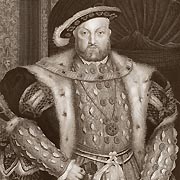 |
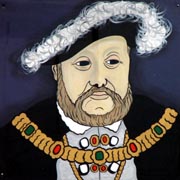 |
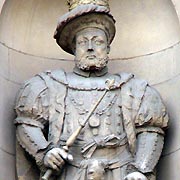
|
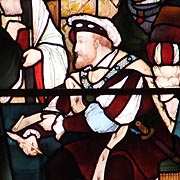
|
Henry VIII was the second son of King Henry VII and Elizabeth of York, the daughter of King Edward IV. He was born at Greenwich Palace and became heir to the throne on the death of his brother, Arthur, in 1502. Two years later, a dispensation arrived from the Pope to enable him to marry his brother's widow, Catherine of Aragon, but he protested, at the time, against the dispensation and, until his own accession to the throne, it did not seem certain that the marriage would take place. Henry received the most careful and learned education, and became an accomplished scholar in the best sense of the term. He was also a fine athlete and of great bodily strength.
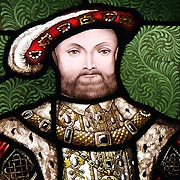
|
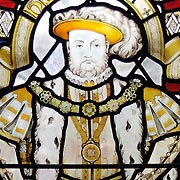
|
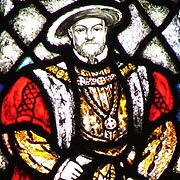
|
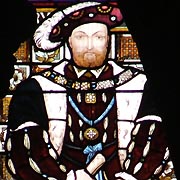
|
For almost fifteen years after his accession to the throne in 1509, no one suspected that Henry was any more than a pleasure-loving monarch of great natural gifts and graces, as well as of much extravagance, who was content to pass his time in a series of tournaments and revels, and to leave business to his ministers, especially to Cardinal Wolsey. He married Catherine two months after his accession and had, by her, several children, all of whom, except Princess Mary, born in 1516, died in infancy. He engaged in two futile wars with France, in 1512 and 1522, and thus spoiled his father's excellent understanding with the Scots. He professed excessive devotion to the Holy See and, even in after years, all the doctrines and ritual of the old Church remained dear to him. During this period, taxation was heavy and was by no means cheerfully borne.
Sometime between 1525 and 1529, a complete change came over Henry's character and method of government. He may be said to have awakened, and the results of this, if on the whole of enormous benefit to his country, were very terrible to many of the old interests in that country. He desired, not wholly for immoral reasons, a divorce from Catherine, for he was anxious to secure the English succession to a son, and he professed that his conscience was uneasy at the thought of his long but unhallowed union with a brother's wife. Every man and every interest that stood in the way of the Royal will had now to be swept from Henry's path. Among these interests was the Church of Rome, as the Popes of that age understood it. Pope Clement VII was ready to give Henry a dispensation to have two wives at once but, for political reasons, he was unable to grant a divorce from Catherine, for he was in the clutches of the Emperor Charles V, who was her nephew. Henry turned, in 1529, to the people of England, that is to the upper classes who were represented in the House of Commons. These had, for two centuries or more, hated and despised the foreign-hearted Papal Church and, while not wishing as yet for any innovations in doctrine, were quite ready to join the King in the confiscation of clerical property and in the wholesale abolition of the Papal authority in England. Though, at first, the House of Lords, where bishops, abbots and conservative peers were strong, gave some trouble. Henry and his devoted Houses of Commons ended by sweeping all before them. Cardinal Wolsey, the Papal headship of the Church, the monasteries and the monastic orders successively fell, and the Crown and the laity were enriched with their spoils. All payments to Rome were forbidden, and all appeals, and the supremacy of the Crown over the Church was entirely established. This was not accomplished without much resistance both from individuals and corporations, nor even without an insurrection in the North, in 1536, which at the time threatened to be serious. But each successive movement of resistance was stamped out in blood and fire, and the numerous executions, which might well have been avoided (for almost the whole force and intelligence of his people was upon Henry's side), have left a terrible stain on the King's name. Political exigencies occasionally led the government into coquetry with the princes of Germany, where the doctrinal reformation was in full blast, but, when the Lutheran doctrines began to spread to England, Henry ruthlessly stamped them out, and twenty-eight 'heretics' were burned during his reign.
A terrible tyrant to his enemies, Henry was never in the least a tyrant to the mass of his people, who loved, trusted and honoured him to the end. He, in return, also trusted and trained them to the use of arms and to a national self-consciousness and pride that had been quite lost since the death of Henry V. He was the true founder of the British Navy and a devoted student of all matters connected with the sea, and especially of naval construction and gunnery. He was a true patron of English commerce, which he fostered and protected as no one had done since Edward III. He was a true patron of learning, as his Royal foundations at both Universities testify. Finally, he was the King who first taught the House of Commons to take its true place as the exponent of the will of the intelligent classes of England.
In spite of his six successive marriages, Henry left but three children: Mary, the daughter of Catherine of Aragon; Elizabeth, the daughter of Anne Boleyn; and Edward VI, the son of Jane Seymour. By his last three wives, Anne of Cleves, Katherine Howard and Katharine Parr, he had no children. He had at least one illegitimate son, the Duke of Richmond, who died before him. In spite of his success and his noble patriotism, Henry's private character must be pronounced detestable. Alone of his wives, Jane Seymour, was parted from him by a natural death. Two of them, he beheaded. He was a cruel man who rejoiced in spilling the blood of his enemies. He was wickedly and often uselessly extravagant. And he made all this appear worse in the eyes of posterity by his ostentatious assumption of righteousness and his perpetual talk about his conscience.
Edited from CRL Fletcher's 'Historical Portraits' (1909)
The pictures on this page are cropped examples of images in the high resolution Nash Ford Photo Library. Please e-mail us for details of these or similar image availability at our very reasonable reproduction rates. Location release may be required for some photos.
Click for Next
Monarch